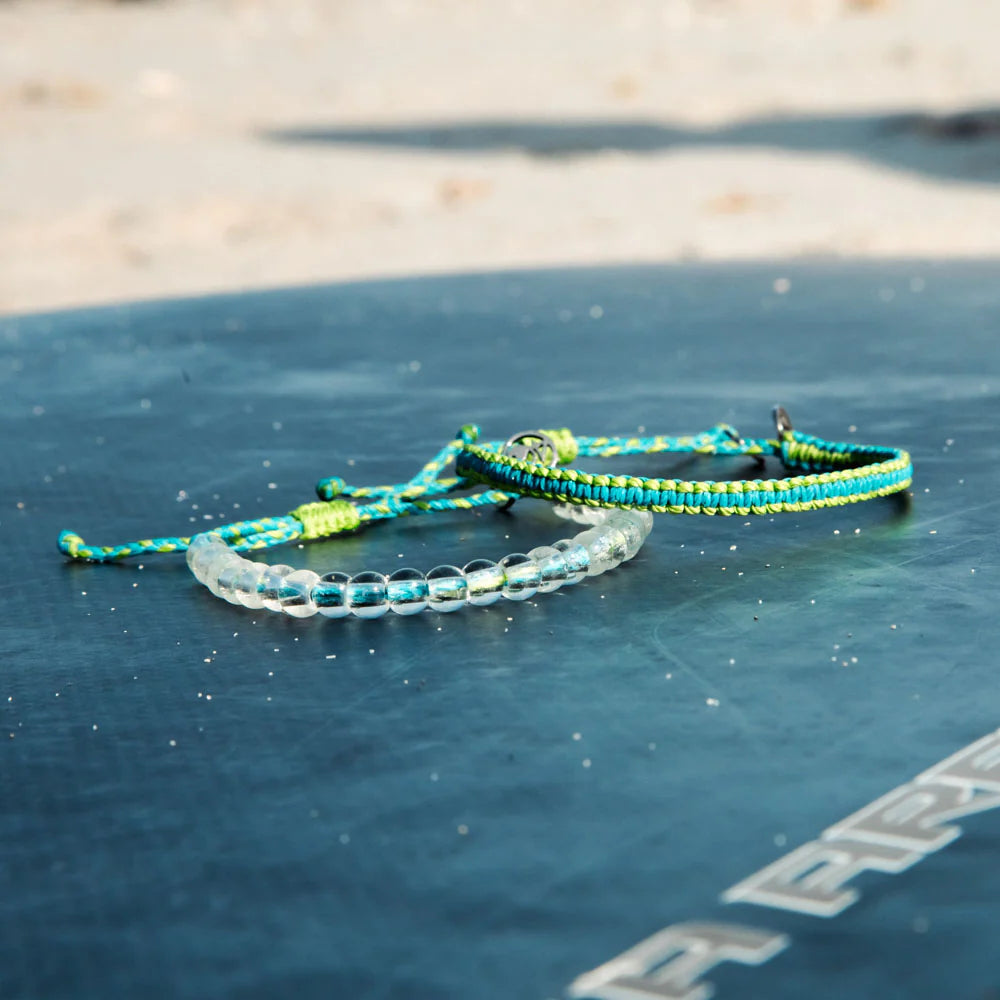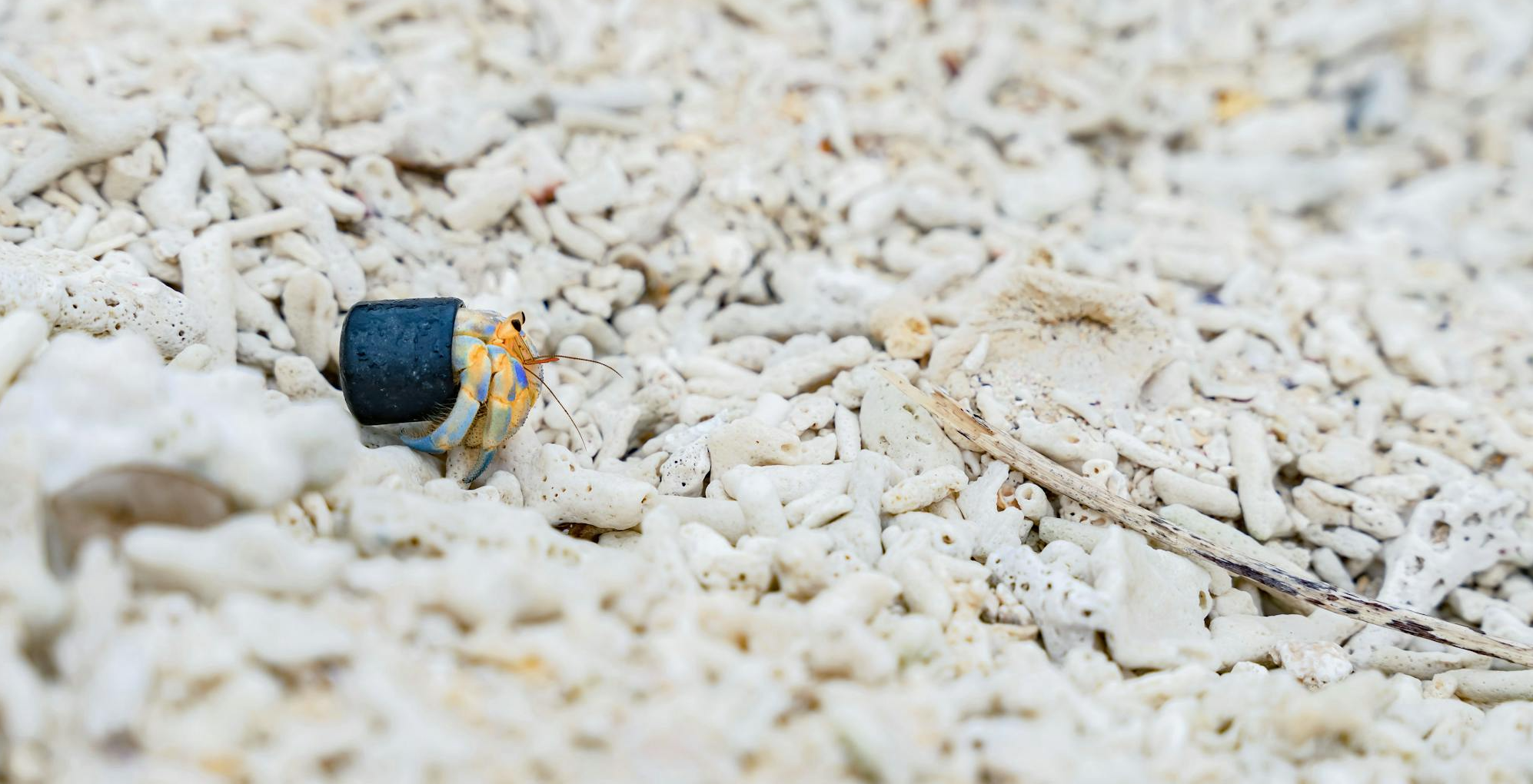5 MIN READ
4-15-2024
The Shell Crisis:
A Hermit Crab’s
Deadly Home
Mikaela Walsh, 4ocean Research Analyst
A new oceanic plastic crisis consumes marine organisms. A story on the hermit crab’s trial for survival.
The animal that has been widely seen to fall into this crisis is the hermit crab. There are over eight hundred different species of hermit crab, all with unique characteristics. The individual species contain different adaptations and features that allow them to have specific niches. Most hermit crab species reside on the ocean floor and spend their lives underwater in the sea. There are a little over a dozen species that are semi-terrestrial and spend the majority of their life on land. These semi-terrestrials spend the first stages of their life cycle on the ocean floor. Also, they must use the ocean for reproductive purposes. The terrestrial hermit crabs will frequent the sea for various purposes but are mainly settled along the coastlines. These organisms have claws with a rugged exterior, similar to a typical crab, but lack a hard exterior around the animal's entire body. In fact, the hermit crab's body is very soft. This makes them vulnerable to predators and harsh environments. Due to this, they seek out shells as their homes for safeguarding.

Various marine animals use shells as a means of protection and camouflage. Unlike other organisms that reside in shells, hermit crabs lack the ability to produce shells from calcium carbonate. Instead, they must find abandoned homes made from other animals on the ocean floor and along the seashore. Hermit crabs have soft bodies with muscles to hold onto the shell they reside in with curvature. This circular curvature is beneficial to these animals to ensure the shell does not become loose, exposing their body to the natural environment. Many semi-terrestrial hermit crabs will travel along the water’s edge, hoping to find a new home as they outgrow their old shell. The struggle to find suitable shells is exasperated as plastic debris emerges.
Hermit crabs have been observed globally in new “shells.” But, not the classic shell you may presume—a new, cheap, and deadly shell. Hermit crabs are utilizing plastic debris items as shells. This is a very astonishing and heartbreaking consequence of plastic pollution.

Do not be mistaken; this does not mean plastic pollution positively affects the environment; it is quite the contrary. With new technology alongside the ability to quantify various regions, examining hermit crabs using plastic debris worldwide is now possible. This platform, iEcology, has provided scientists with the resources to quantify that this is a global issue occurring, not just regionally. Using this, scientists could examine 386 different occurrences and know the species of hermit crab and the debris item that was used. Commonly seen items include plastic, metal, and glass, but plastic items were observed in nearly 85% of all occurrences; most of the instances were plastic bottle caps.
Further examination of this needs to be followed to determine how
this could affect the evolution of this animal. Mating behavior and fitness of hermit crabs could be a consequence of this issue. Plastic debris is usually less dense than natural shells, causing these animals to have potentially lower fitness levels and exert less energy. This behavior could drastically affect mating behaviors due to the appearance of shells being a key indicator for mating selection. A majority of the artificial shell colors were white, followed by black, transparent, red, blue, green, yellow, and so forth. From these findings, ten of the 16 terrestrial hermit crab species were shown to use artificial shells. Terrestrial hermit crabs have many opportunities to find new homes in this plastic debris. Once oceanic plastic washes ashore, it is in the exact location as shells, making it easily mistaken as suitable protection.

Limited Edition
Earth Day 2024 Bracelet
Shop now + Clean the Ocean
Using plastic debris as their shells is disastrous. To worsen the problem, these hermit crabs face another obstacle: entrapment. These terrestrial hermit crabs find new homes in the washed-ashore shells along the coastline. Along this coast, there aren’t only shells that are beginning to wash up but also plastic debris items. This debris can range anywhere from plastic bottle caps to large plastic containers. Researchers examined the plastic debris along the coastline in this region that the hermit crabs had direct access to. They determined whether or not this plastic debris posed a threat of potential entrapment and collected data on the presence of this threat. This analysis entailed if the lid of a container was missing and the capability to escape these items, as well as if the opening was facing upward to entrap the hermit crabs. Then, they counted the number of dead and alive crabs inside the containers. They estimate that 570,000 crabs can become entrapped on only two tropical islands, not including the rest of the world. When these animals become entrapped, they cannot escape and find food, which causes them to die. The presence of plastic container items along the coastline causes significant concern about the longevity of hermit crabs, not only on these islands but across the globe.

Hermit crabs are distinctive animals important for nutrient cycling within the subtidal and intertidal zones on the beach. These hermit crabs can also assist in seed dispersion within the coastal zone. Hermit crabs face many survival challenges due to plastic debris washing ashore in the coastal zones. Using plastic debris as shells is a tragedy that can be stopped with increased conservation efforts and ocean clean-ups. Entrapment is another significant and deadly issue that these minuscule organisms must face. Plastic debris harms all marine life, but it could be a death sentence for these hermit crabs, which disrupts the entire food web. If you see a hermit crab using plastic debris as its shell, upload it to iEcology so scientists can continue tracking data on the number of occurrences and locations worldwide. We are determined to end the oceanic plastic crisis and help the hermit crabs escape the reality of plastic debris.

Limited Edition
Earth Day 2024 Bracelet
Shop now + Clean the Ocean
You May Also Like



